|
The global market week got off to slow start with many of the major indexes in Asia and Europe closed for Easter Monday. Investors were, therefore, slow to react to the April 6th U.S. employment report — they sold on the disappointing report. But there were more reasons for investors to be risk averse. Other economic data included a spate of reports from China. And there is always investor angst as earnings season begins.
Political worries stemming from anticipation of North Korea’s missle test and its ultimate failure kept investors on alert in Japan, South Korea and elsewhere in the region. Another political uncertainty — this time in Europe — stems from the two national elections scheduled on May 6th in Greece and France. And lurking sovereign debt woes in Europe have not gone away, but have shifted to other countries with the yields for Spanish and Italian bonds climbing and with them the spread with German bunds which are at near record lows. While equities in the Asia Pacific region were mixed on the week, those in Europe, the UK and U.S. were lower.
|
|
2011 |
2012 |
% Change |
|
Index |
Dec 30 |
April 6 |
April 13 |
Week |
Year |
| Asia/Pacific |
|
|
|
|
|
|
| Australia |
All Ordinaries |
4111 |
4420.0 |
4403.8 |
0.0% |
7.1% |
| Japan |
Nikkei 225 |
8455.35 |
10083.6 |
9638.0 |
-0.5% |
14.0% |
| Hong Kong |
Hang Seng |
18434.39 |
20555.6 |
20701.0 |
0.5% |
12.3% |
| S. Korea |
Kospi |
1825.74 |
2014.0 |
2008.9 |
-1.0% |
10.0% |
| Singapore |
STI |
2646.35 |
3010.5 |
2987.8 |
0.1% |
12.9% |
| China |
Shanghai Composite |
2199.42 |
2262.8 |
2359.2 |
2.3% |
7.3% |
|
|
|
|
|
|
|
| India |
Sensex 30 |
15454.92 |
17404.2 |
17094.5 |
-2.2% |
10.6% |
| Indonesia |
Jakarta Composite |
3821.99 |
4121.6 |
4159.3 |
-0.2% |
8.8% |
| Malaysia |
KLCI |
1530.73 |
1596.3 |
1603.1 |
0.3% |
4.7% |
| Philippines |
PSEi |
4371.96 |
5107.7 |
5097.3 |
1.2% |
16.6% |
| Taiwan |
Taiex |
7072.08 |
7933.0 |
7788.3 |
1.1% |
10.1% |
| Thailand |
SET |
1025.32 |
1196.8 |
1169.5 |
-1.1% |
14.1% |
|
|
|
|
|
|
|
| Europe |
|
|
|
|
|
|
| UK |
FTSE 100 |
5572.28 |
5768.5 |
5651.8 |
-1.3% |
1.4% |
| France |
CAC |
3159.81 |
3423.8 |
3189.1 |
-3.9% |
0.9% |
| Germany |
XETRA DAX |
5898.35 |
6946.8 |
6583.9 |
-2.8% |
11.6% |
| Italy |
FTSE MIB |
15089.74 |
15980.1 |
14359.5 |
-5.6% |
-4.8% |
| Spain |
IBEX 35 |
8566.3 |
8008.0 |
7250.6 |
-5.4% |
-15.4% |
| Sweden |
OMX Stockholm 30 |
987.85 |
1074.5 |
1027.7 |
-0.8% |
4.0% |
| Switzerland |
SMI |
5936.23 |
6235.5 |
6072.1 |
-1.5% |
2.3% |
|
|
|
|
|
|
|
| North America |
|
|
|
|
|
|
| United States |
Dow |
12217.56 |
13212.0 |
12849.6 |
-1.6% |
5.2% |
|
NASDAQ |
2605.15 |
3091.6 |
3011.3 |
-2.2% |
15.6% |
|
S&P 500 |
1257.6 |
1408.5 |
1370.3 |
-2.0% |
9.0% |
| Canada |
S&P/TSX Comp. |
11955.09 |
12392.2 |
12040.4 |
-0.5% |
0.7% |
| Mexico |
Bolsa |
37077.52 |
39521.2 |
38443.9 |
-2.4% |
3.7% |
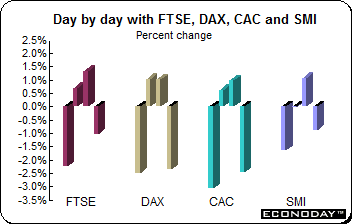 Equities were down for a second (holiday shortened) week as disappointing economic data along with simmering Spanish woes sent investors to the sidelines. Markets were closed for Easter Monday. When they reopened Tuesday, equities declined — it was the first opportunity for investors here to react to the disappointing U.S. employment report that had been released on April 6th when markets here were closed for Good Friday. However, spirits revived mid-week on comments in the Federal Reserve’s Beige Book and from Fed officials. According to the Beige Book which is prepared prior to each FOMC meeting, the economic recovery has been proceeding at a modest pace as manufacturers expressed optimism despite concerns about higher energy prices. Consumer spending was "encouraging" across a number of the Fed's 12 districts. Equities were down for a second (holiday shortened) week as disappointing economic data along with simmering Spanish woes sent investors to the sidelines. Markets were closed for Easter Monday. When they reopened Tuesday, equities declined — it was the first opportunity for investors here to react to the disappointing U.S. employment report that had been released on April 6th when markets here were closed for Good Friday. However, spirits revived mid-week on comments in the Federal Reserve’s Beige Book and from Fed officials. According to the Beige Book which is prepared prior to each FOMC meeting, the economic recovery has been proceeding at a modest pace as manufacturers expressed optimism despite concerns about higher energy prices. Consumer spending was "encouraging" across a number of the Fed's 12 districts.
Stocks also were bolstered by Fedspeak and by remarks from Bank of Japan Governor Masaaki Shirakawa who pledged to continue to add monetary stimulus amid growing calls from politicians for the BoJ to do more to end deflation. Many Fed speakers were scheduled during the week and captured investors’ attention. They offered their diverse views on whether or not QE3 is needed. However, on Friday, equities slumped after China’s GDP grew less than expected and the preliminary estimate of April U.S. consumer sentiment retreated. In addition, news that Spanish banks have increased their borrowing from the ECB dragged shares of European banks lower.
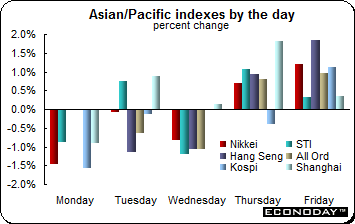 Unlike those in the U.S. and in Europe and the UK, equities here were mixed last week as concerns about sovereign debt in Europe resurfaced. Although the indexes recovered on the last two days of the week, it was too little and too late to lift them for a positive finish. Stocks were buoyed somewhat on Friday after a planned North Korean missile test failed early in flight. They were also buoyed by earnings reports from Alcoa and Google. The latter helped to remove some of the sting from China’s disappointing GDP report. However, the weaker Chinese data spurred talk of further policy easing steps from Beijing to support the economy. Unlike those in the U.S. and in Europe and the UK, equities here were mixed last week as concerns about sovereign debt in Europe resurfaced. Although the indexes recovered on the last two days of the week, it was too little and too late to lift them for a positive finish. Stocks were buoyed somewhat on Friday after a planned North Korean missile test failed early in flight. They were also buoyed by earnings reports from Alcoa and Google. The latter helped to remove some of the sting from China’s disappointing GDP report. However, the weaker Chinese data spurred talk of further policy easing steps from Beijing to support the economy.
Japanese shares advanced for the first time in eight sessions, as a pause in the yen's resurgence and expectations of further monetary easing by the Bank of Japan helped lift stocks. However, the Nikkei was down 0.5 percent for the week. The All Ordinaries snapped back into gains Thursday as well. Australian employment was up by a much greater amount than analysts forecast. The index was virtually unchanged for the week. Elsewhere, the Hang Seng was up 0.5 percent while the Shanghai Composite jumped 2.3 percent on the week.
Bank of Japan
 As expected, the Bank of Japan left its key monetary interest rate range between zero and 0.1 percent. The vote was unanimous. The Bank also left its asset buying program at ¥65 trillion. The Bank said that the economy has shown signs of improving but economic activity is more or less flat. The monetary policy board noted that uncertainty remains high about the global economy’s strength. It repeated that it expects the Japanese economy to return to a moderate recovery path. The MPB also announced that it would set the interest rate on one year dollar loans at the six month U.S. dollar LIBOR. As expected, the Bank of Japan left its key monetary interest rate range between zero and 0.1 percent. The vote was unanimous. The Bank also left its asset buying program at ¥65 trillion. The Bank said that the economy has shown signs of improving but economic activity is more or less flat. The monetary policy board noted that uncertainty remains high about the global economy’s strength. It repeated that it expects the Japanese economy to return to a moderate recovery path. The MPB also announced that it would set the interest rate on one year dollar loans at the six month U.S. dollar LIBOR.
The BoJ has been under pressure from the government to take more action, with the yen strengthening once again with the recent equity rally appearing to have run out of steam. The Bank is believed to be still monitoring the impact of its February move to expand its asset purchasing program by ¥10 trillion yen to ¥65 trillion yen. But now that the effect of February's monetary easing is wearing off, expectations are growing that the Bank of Japan will relax its monetary policy further later this month when the monetary policy board meets on April 27th.
Bank of Korea
 As expected, the Bank of Korea kept its key interest rate at 3.25 percent for the 10th straight month. Inflation has eased to 2.6 percent — a 20 month low — and is now comfortably within the BoK’s inflation target range of 2 percent to 4 percent. The Bank believes that U.S. economic conditions are continuing to improve, although Europe remains a source of concern. The emerging markets are beginning to slow because of a decline in exports according to the BoK. As expected, the Bank of Korea kept its key interest rate at 3.25 percent for the 10th straight month. Inflation has eased to 2.6 percent — a 20 month low — and is now comfortably within the BoK’s inflation target range of 2 percent to 4 percent. The Bank believes that U.S. economic conditions are continuing to improve, although Europe remains a source of concern. The emerging markets are beginning to slow because of a decline in exports according to the BoK.
 The euro was virtually unchanged on the week but the currency was sagging against most of its major counterparts as the week ended. Investors were betting that the European Central Bank will not launch another round of government bond purchases even as Spanish credit default swaps rose to a record. Friday’s slump occurred after Klaas Knot, a member of the ECB governing council, said he did not see a “good reason” to buy Spanish securities. He opined that there appeared to have been “an overreaction to the unfortunate communication surrounding Spain.” Analysts noted that markets are realizing that fiscal consolidation is very challenging when you do not have economic growth. The euro was virtually unchanged on the week but the currency was sagging against most of its major counterparts as the week ended. Investors were betting that the European Central Bank will not launch another round of government bond purchases even as Spanish credit default swaps rose to a record. Friday’s slump occurred after Klaas Knot, a member of the ECB governing council, said he did not see a “good reason” to buy Spanish securities. He opined that there appeared to have been “an overreaction to the unfortunate communication surrounding Spain.” Analysts noted that markets are realizing that fiscal consolidation is very challenging when you do not have economic growth.
The yen was up much to exporters’ dismay on flight to safety concerns and weak Chinese data. The currency strengthened earlier in the week after Japan reported a ¥1.18 trillion surplus in its February current account. Japan had a record deficit in January. Japan’s currency tends to strengthen during global economic turmoil because the nation’s current account surplus makes it less reliant on foreign capital.
The Swiss franc breached the 1.20 limit per euro early in Asian trading Monday, the second time the barrier had been crossed since the Swiss National Bank introduced the currency cap on September 6, 2011. The franc had reached the strongest level since the SNB established the limit to protect exports after investors seeking a haven from the euro area turmoil drove the currency to a record. The move was a blip, but it says that the market continues to test the floor at times when liquidity is virtually nonexistent amid concern over the European debt crisis.
Selected currencies — weekly results
|
|
2011 |
2012 |
% Change |
|
|
Dec 30 |
Apr 5 |
Apr 13 |
Week |
2012 |
| U.S. $ per currency |
|
|
|
|
|
|
| Australia |
A$ |
1.023 |
1.030 |
1.037 |
0.7% |
1.4% |
| New Zealand |
NZ$ |
0.778 |
0.816 |
0.823 |
0.9% |
5.8% |
| Canada |
C$ |
0.982 |
1.006 |
1.002 |
-0.5% |
2.0% |
| Eurozone |
euro (€) |
1.294 |
1.306 |
1.308 |
0.1% |
1.1% |
| UK |
pound sterling (£) |
1.554 |
1.582 |
1.585 |
0.1% |
2.0% |
|
|
|
|
|
|
|
| Currency per U.S. $ |
|
|
|
|
|
|
| China |
yuan |
6.295 |
6.309 |
6.298 |
0.2% |
0.0% |
| Hong Kong |
HK$* |
7.767 |
7.764 |
7.759 |
0.1% |
0.1% |
| India |
rupee |
53.065 |
51.175 |
51.525 |
-0.7% |
3.0% |
| Japan |
yen |
76.975 |
82.400 |
81.030 |
1.7% |
-5.0% |
| Malaysia |
ringgit |
3.168 |
3.069 |
3.056 |
0.4% |
3.7% |
| Singapore |
Singapore $ |
1.297 |
1.259 |
1.247 |
1.0% |
4.0% |
| South Korea |
won |
1152.450 |
1128.830 |
1133.750 |
-0.4% |
1.6% |
| Taiwan |
Taiwan $ |
30.279 |
29.510 |
29.506 |
0.0% |
2.6% |
| Thailand |
baht |
31.580 |
30.990 |
30.760 |
0.7% |
2.7% |
| Switzerland |
Swiss franc |
0.939 |
0.920 |
0.920 |
0.0% |
2.1% |
| *Pegged to U.S. dollar |
|
|
|
|
|
|
| Source: Bloomberg |
|
|
|
|
|
|
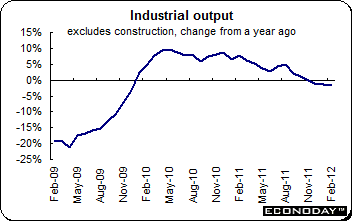 February industrial production was up 0.5 percent and was down 1.7 percent on the year. Energy dominated the February advance with a 7.7 percent monthly spurt on the back of a sharp decline in temperatures across much of the region. Capital goods (0.7 percent) also enjoyed a good period but there were sizeable declines in intermediates as well as durable (2.0 percent) and nondurable (1.6 percent) consumer goods. Among the larger member states, output was up on the month in France (0.2 percent) and Germany (1.3 percent) but Spain saw another decline (0.5 percent) and, despite no official figures being available, national data strongly suggest that Italy followed suit. February industrial production was up 0.5 percent and was down 1.7 percent on the year. Energy dominated the February advance with a 7.7 percent monthly spurt on the back of a sharp decline in temperatures across much of the region. Capital goods (0.7 percent) also enjoyed a good period but there were sizeable declines in intermediates as well as durable (2.0 percent) and nondurable (1.6 percent) consumer goods. Among the larger member states, output was up on the month in France (0.2 percent) and Germany (1.3 percent) but Spain saw another decline (0.5 percent) and, despite no official figures being available, national data strongly suggest that Italy followed suit.
 February seasonally adjusted merchandise trade balance narrowed from a larger revised €15.1 billion in January to a still very substantial €13.6 billion in February. The shrinkage in the surplus reflected a 1.6 percent monthly increase in nominal exports that was easily outpaced by a 3.9 percent spurt in imports but both sides of the balance sheet saw new record highs. On an annual basis, exports were up 8.6 percent, 2.5 percentage points more than the increase in imports. The relative weakness of the other EMU markets continues to be highlighted in the year over year comparisons. Within the overall gain in exports, purchases by the rest of the Eurozone were up just 3.3 percent, fully 10 percentage points less than the gain in sales to non-EU countries. February seasonally adjusted merchandise trade balance narrowed from a larger revised €15.1 billion in January to a still very substantial €13.6 billion in February. The shrinkage in the surplus reflected a 1.6 percent monthly increase in nominal exports that was easily outpaced by a 3.9 percent spurt in imports but both sides of the balance sheet saw new record highs. On an annual basis, exports were up 8.6 percent, 2.5 percentage points more than the increase in imports. The relative weakness of the other EMU markets continues to be highlighted in the year over year comparisons. Within the overall gain in exports, purchases by the rest of the Eurozone were up just 3.3 percent, fully 10 percentage points less than the gain in sales to non-EU countries.
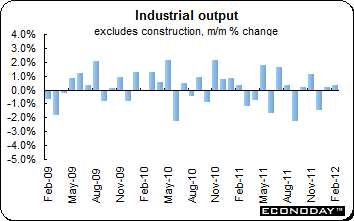 February industrial production was up 0.3 percent on the month but was 1.9 percent lower on the year. The monthly increase was entirely attributable to a 10.2 percent monthly surge in mining & quarrying & utilities output, itself a reflection of a jump in energy demand due to cold weather. More significantly, manufacturing posted a 1.2 percent decline from January. Within manufacturing, refining was off a further 5.1 percent on the month after a 12 percent slump in January but there were drops also in both electronics & machinery (1.8 percent) and in the other manufactured goods area (1.7 percent). As a result, modest gains in food & agriculture (0.4 percent) and in transport equipment (0.1 percent) made little impression on the monthly change in total output. February industrial production was up 0.3 percent on the month but was 1.9 percent lower on the year. The monthly increase was entirely attributable to a 10.2 percent monthly surge in mining & quarrying & utilities output, itself a reflection of a jump in energy demand due to cold weather. More significantly, manufacturing posted a 1.2 percent decline from January. Within manufacturing, refining was off a further 5.1 percent on the month after a 12 percent slump in January but there were drops also in both electronics & machinery (1.8 percent) and in the other manufactured goods area (1.7 percent). As a result, modest gains in food & agriculture (0.4 percent) and in transport equipment (0.1 percent) made little impression on the monthly change in total output.
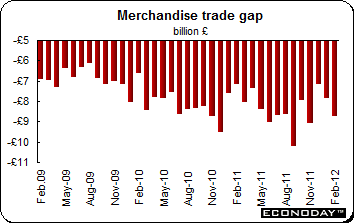 February global shortfall on goods widened sharply from a larger revised Stg7.9 billion at the start of the year to Stg8.8 billion in February. The deterioration solely reflected a 3.4 percent monthly decline in exports while imports held steady at their January level. The disappointing performance by the headline data was largely mirrored in the underlying balance which showed a deficit of Stg7.9 billion, up sharply from Stg7.1 billion last time. All of the increase in the overall deficit was attributable to a marked worsening in trade with non-EU countries. Here an 8.8 percent monthly drop in exports combined with a 1.0 percent increase in imports to boost the bilateral shortfall from Stg3.7 billion to Stg5.0 billion. Foreign demand for cars was notably weaker although this may just be a timing issue as the same area saw a substantial advance in January. Meantime, the deficit with the rest of the EU shrank by Stg0.4 billion to Stg3.8 billion as exports grew 1.9 percent on the month and imports slipped 0.9 percent. February global shortfall on goods widened sharply from a larger revised Stg7.9 billion at the start of the year to Stg8.8 billion in February. The deterioration solely reflected a 3.4 percent monthly decline in exports while imports held steady at their January level. The disappointing performance by the headline data was largely mirrored in the underlying balance which showed a deficit of Stg7.9 billion, up sharply from Stg7.1 billion last time. All of the increase in the overall deficit was attributable to a marked worsening in trade with non-EU countries. Here an 8.8 percent monthly drop in exports combined with a 1.0 percent increase in imports to boost the bilateral shortfall from Stg3.7 billion to Stg5.0 billion. Foreign demand for cars was notably weaker although this may just be a timing issue as the same area saw a substantial advance in January. Meantime, the deficit with the rest of the EU shrank by Stg0.4 billion to Stg3.8 billion as exports grew 1.9 percent on the month and imports slipped 0.9 percent.
 March producer output prices were up 0.6 percent and 3.6 percent on the year. Input prices jumped 1.9 percent and 5.8 percent on the year. The latest spurt in factory gate charges was again in large part driven by higher petrol prices which alone added more than 0.3 percentage points to the overall monthly change. Elsewhere prices were generally quite restrained although tobacco & alcohol (1.1 percent) also registered an above average monthly gain on higher excise duties. The core index edged just 0.1 percent firmer from February and was 2.5 percent higher on the year after a 3.0 percent rise last time. Input costs were similarly lifted on the month by a sharp jump in crude oil prices (6.3 percent). This added 1.8 percentage points to the monthly gain. Imported food materials (1.0 percent) and other imported materials (1.6 percent) were also robust but other increases were relatively mild and fuel was off 1.5 percent. March producer output prices were up 0.6 percent and 3.6 percent on the year. Input prices jumped 1.9 percent and 5.8 percent on the year. The latest spurt in factory gate charges was again in large part driven by higher petrol prices which alone added more than 0.3 percentage points to the overall monthly change. Elsewhere prices were generally quite restrained although tobacco & alcohol (1.1 percent) also registered an above average monthly gain on higher excise duties. The core index edged just 0.1 percent firmer from February and was 2.5 percent higher on the year after a 3.0 percent rise last time. Input costs were similarly lifted on the month by a sharp jump in crude oil prices (6.3 percent). This added 1.8 percentage points to the monthly gain. Imported food materials (1.0 percent) and other imported materials (1.6 percent) were also robust but other increases were relatively mild and fuel was off 1.5 percent.
 February machine orders excluding volatile items jumped 4.8 percent on the month after increasing 3.4 percent the month before. The gain was far beyond analysts expectations of a 0.8 percent drop. On the year, orders were up 8.9 percent. Total orders dropped 14.5 percent. Private sector orders were down 3.0 percent. Within private orders, manufacturing machine orders were 16.0 percent higher after declining in the previous two months. Nonmanufacturing orders were up 2.3 percent for a second month. Orders from overseas slumped 18.3 percent after rising 20.1 percent in January. February machine orders excluding volatile items jumped 4.8 percent on the month after increasing 3.4 percent the month before. The gain was far beyond analysts expectations of a 0.8 percent drop. On the year, orders were up 8.9 percent. Total orders dropped 14.5 percent. Private sector orders were down 3.0 percent. Within private orders, manufacturing machine orders were 16.0 percent higher after declining in the previous two months. Nonmanufacturing orders were up 2.3 percent for a second month. Orders from overseas slumped 18.3 percent after rising 20.1 percent in January.
 March corporate goods price index was up 0.6 percent both on the month and on the year. It was the 18th straight month that the index has increased when compared to a year ago. Manufacturing prices were up 0.1 percent on the year after increasing 0.2 percent in February. Within manufacturing, petroleum and coal products jumped 7.0 percent after increasing 6.0 percent the month before. Pulp & paper products were up 3.2 percent after 3.0 percent last time. Information & communications equipment dropped 7.9 percent after 7.6 percent a month ago. Electronic components & devices were down 1.9 percent after slipping 1.6 percent last time. March corporate goods price index was up 0.6 percent both on the month and on the year. It was the 18th straight month that the index has increased when compared to a year ago. Manufacturing prices were up 0.1 percent on the year after increasing 0.2 percent in February. Within manufacturing, petroleum and coal products jumped 7.0 percent after increasing 6.0 percent the month before. Pulp & paper products were up 3.2 percent after 3.0 percent last time. Information & communications equipment dropped 7.9 percent after 7.6 percent a month ago. Electronic components & devices were down 1.9 percent after slipping 1.6 percent last time.
 March employment jumped by 43,900 to 11,491,200. The unemployment rate remained at 5.2 percent for a second month. The increase in employment was driven by increased full time employment which was up by 15,800 to 8,080,400 and part time employment which was up 28,200 to 3,410,900. The number of people unemployed declined by 3,200 people to 629,100 in March. The labour force participation rate was 65.4 percent, up from 65.2 percent in February. March employment jumped by 43,900 to 11,491,200. The unemployment rate remained at 5.2 percent for a second month. The increase in employment was driven by increased full time employment which was up by 15,800 to 8,080,400 and part time employment which was up 28,200 to 3,410,900. The number of people unemployed declined by 3,200 people to 629,100 in March. The labour force participation rate was 65.4 percent, up from 65.2 percent in February.
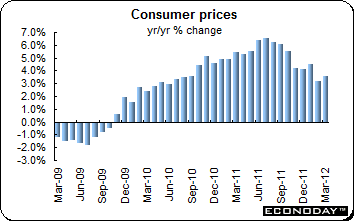 March consumer price index was up more than expected. The CPI was up 3.6 percent on the year while analysts expected a 3.3 percent increase. The index was up 0.2 percent on the month. Both the urban and rural indexes were also up 3.6 percent. Food prices were up 7.5 percent after increasing 6.2 percent in February. Non-food was up 1.8 percent, about the same as in February. Clothing prices were 3.8 percent higher, the same as the month before. Health care prices subsided to a 2.2 percent increase from 2.5 percent the month before. First quarter CPI was up 3.8 percent in 2012 compared with an increase of 5.0 percent in the first quarter of 2011. March consumer price index was up more than expected. The CPI was up 3.6 percent on the year while analysts expected a 3.3 percent increase. The index was up 0.2 percent on the month. Both the urban and rural indexes were also up 3.6 percent. Food prices were up 7.5 percent after increasing 6.2 percent in February. Non-food was up 1.8 percent, about the same as in February. Clothing prices were 3.8 percent higher, the same as the month before. Health care prices subsided to a 2.2 percent increase from 2.5 percent the month before. First quarter CPI was up 3.8 percent in 2012 compared with an increase of 5.0 percent in the first quarter of 2011.
 March producer prices were down 0.3 percent on the year after remaining flat in February. On the month the PPI was up 0.3 percent. Raw materials prices inched up 0.1 percent after increasing 1.0 percent the month before. Production prices slid 0.8 percent after declining 0.5 percent. Consumer prices however, were up 1.4 percent after rising 1.7 percent in February. Ferrous metals and non-ferrous metal prices were down 4.2 percent and 4.0 percent respectively. In the first quarter, the PPI inched up 0.1 percent. For the same quarter a year ago, the PPI jumped 7.0 percent. March producer prices were down 0.3 percent on the year after remaining flat in February. On the month the PPI was up 0.3 percent. Raw materials prices inched up 0.1 percent after increasing 1.0 percent the month before. Production prices slid 0.8 percent after declining 0.5 percent. Consumer prices however, were up 1.4 percent after rising 1.7 percent in February. Ferrous metals and non-ferrous metal prices were down 4.2 percent and 4.0 percent respectively. In the first quarter, the PPI inched up 0.1 percent. For the same quarter a year ago, the PPI jumped 7.0 percent.
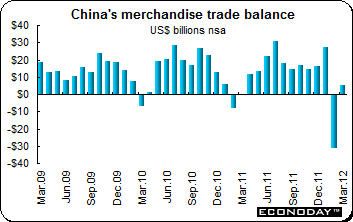 March unadjusted merchandise trade balance recorded an unexpected surplus of $5.35 billion – analysts expected a deficit of $3.15 billion. Exports were up 8.9 percent on the year while imports were up 5.3 percent. For the first quarter, exports were up 7.6 percent when compared with the first quart of the previous year while imports were up 6.9 percent. The first quarter trade balance was a surplus of $670 million. On a seasonally adjusted basis, exports were 9.8 percent higher on the year while imports were up 4.6 percent. March unadjusted merchandise trade balance recorded an unexpected surplus of $5.35 billion – analysts expected a deficit of $3.15 billion. Exports were up 8.9 percent on the year while imports were up 5.3 percent. For the first quarter, exports were up 7.6 percent when compared with the first quart of the previous year while imports were up 6.9 percent. The first quarter trade balance was a surplus of $670 million. On a seasonally adjusted basis, exports were 9.8 percent higher on the year while imports were up 4.6 percent.
 First quarter gross domestic product was up 8.1 percent when compared with the same quarter a year ago after growing 8.9 percent in the fourth quarter of 2011. It was its slowest pace of growth in nearly three years. GDP was up 1.8 percent from the previous quarter. The National Bureau of Statistics said that activity during the quarter was ‘still in a reasonable range.’ At the same time, NBS warned of outstanding problems in the economy, including the difficulty in stabilizing exports, ongoing inflationary pressures and falling industrial profitability. It cited the need of balancing the support of growth with controlling inflation. First quarter gross domestic product was up 8.1 percent when compared with the same quarter a year ago after growing 8.9 percent in the fourth quarter of 2011. It was its slowest pace of growth in nearly three years. GDP was up 1.8 percent from the previous quarter. The National Bureau of Statistics said that activity during the quarter was ‘still in a reasonable range.’ At the same time, NBS warned of outstanding problems in the economy, including the difficulty in stabilizing exports, ongoing inflationary pressures and falling industrial profitability. It cited the need of balancing the support of growth with controlling inflation.
 March industrial output was up a better than expected 11.9 percent on the year. Analysts expected output to increase 11.2 percent. Output was up 1.22 percent on the month. First quarter output was up 11.6 percent on the year. Output was up for all components. Textile output improved to a gain of 16.9 percent on the year in March from 14.1 percent the month before. Output also improved for machinery output which was up 11.8 percent from 10.2 percent while communication advanced 12.2 percent from 10.9 percent. Steel products output was 10.2 percent higher. Chemicals and non-metal minerals were up 12.6 percent and 13.2 percent respectively. March industrial output was up a better than expected 11.9 percent on the year. Analysts expected output to increase 11.2 percent. Output was up 1.22 percent on the month. First quarter output was up 11.6 percent on the year. Output was up for all components. Textile output improved to a gain of 16.9 percent on the year in March from 14.1 percent the month before. Output also improved for machinery output which was up 11.8 percent from 10.2 percent while communication advanced 12.2 percent from 10.9 percent. Steel products output was 10.2 percent higher. Chemicals and non-metal minerals were up 12.6 percent and 13.2 percent respectively.
 March retail sales were up a slightly better than expected 15.2 percent on the year. Sales were up 1.18 percent on the month. First quarter retail sales were 14.8 percent higher on the year. Urban sales advanced 15.2 percent while rural sales advanced 14.6 percent. All components recorded positive sales including autos which were up 8.1 percent, clothing which jumped 19.4 percent and household nondurables which were 15.7 percent higher on the year. March retail sales were up a slightly better than expected 15.2 percent on the year. Sales were up 1.18 percent on the month. First quarter retail sales were 14.8 percent higher on the year. Urban sales advanced 15.2 percent while rural sales advanced 14.6 percent. All components recorded positive sales including autos which were up 8.1 percent, clothing which jumped 19.4 percent and household nondurables which were 15.7 percent higher on the year.
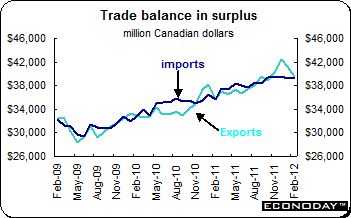 February seasonally adjusted merchandise trade surplus narrowed to C$0.3 billion — the smallest since the balance moved back into surplus in November. It followed a downwardly revised C$1.9 billion excess in January. The deterioration was mainly attributable to a 3.9 percent monthly decline in exports (volumes down 3.5 percent) although imports also subtracted modestly from the bottom line by posting a 0.2 percent advance. Sales to the U.S. were especially weak, down 3.8 percent from January which, with imports from the same territory edging up 0.4 percent, saw the bilateral surplus drop from C$6.1 billion at the start of the year to C$4.8 billion. Within the overall monthly decline in exports, energy slumped nearly 7 percent, in part likely a reflection of disruptions to supply. There was also an 11.9 percent plunge in autos after five successive gains as well as a 4.7 percent drop in agriculture & fishing products. More optimistically, industrial goods & materials were up 1.3 percent while machinery & equipment advanced 0.8 percent. Imports were boosted significantly by an 18.3 percent surge in energy and a 2.1 percent bounce in industrial goods & materials but gains here were essentially offset by declines in autos (6.2 percent), machinery & equipment (2.1 percent) and agricultural & forestry products (7.1 percent). February seasonally adjusted merchandise trade surplus narrowed to C$0.3 billion — the smallest since the balance moved back into surplus in November. It followed a downwardly revised C$1.9 billion excess in January. The deterioration was mainly attributable to a 3.9 percent monthly decline in exports (volumes down 3.5 percent) although imports also subtracted modestly from the bottom line by posting a 0.2 percent advance. Sales to the U.S. were especially weak, down 3.8 percent from January which, with imports from the same territory edging up 0.4 percent, saw the bilateral surplus drop from C$6.1 billion at the start of the year to C$4.8 billion. Within the overall monthly decline in exports, energy slumped nearly 7 percent, in part likely a reflection of disruptions to supply. There was also an 11.9 percent plunge in autos after five successive gains as well as a 4.7 percent drop in agriculture & fishing products. More optimistically, industrial goods & materials were up 1.3 percent while machinery & equipment advanced 0.8 percent. Imports were boosted significantly by an 18.3 percent surge in energy and a 2.1 percent bounce in industrial goods & materials but gains here were essentially offset by declines in autos (6.2 percent), machinery & equipment (2.1 percent) and agricultural & forestry products (7.1 percent).
The Bank of Japan left both its interest rate and asset purchase programs unchanged. They meet again on April 27th when most expect further policy moves. Federal Reserve speakers dominated the news in the period just prior to the pre-meeting Fed blackout period when FOMC members refrain from speaking.
The Bank of Canada meets — no policy change is anticipated. The Bank of England releases the minutes of its meeting held earlier this month. Key data from the UK include consumer prices, retail sales and its labour market report. In Germany, the ZEW survey is on tap. However, most investors will be watching the increasing flow of earnings reports and will be closely monitoring the situation in Spain.
| Central Bank activities |
|
| April 17 |
Canada |
Bank of Canada Monetary Policy Announcement |
| April 18 |
UK |
Bank of England MPC Minutes |
|
|
|
| The following indicators will be released this week... |
| Europe |
|
|
| April 16 |
Eurozone |
Merchandise Trade (February) |
|
Italy |
Merchandise Trade (February) |
| April 17 |
Eurozone |
Harmonized Index of Consumer Prices (March) |
|
Germany |
ZEW Survey (April) |
|
UK |
Consumer Price Index (March) |
| April 18 |
UK |
Labour Market Report (March) |
| April 20 |
UK |
Retail Sales (March) |
|
|
|
| Asia/Pacific |
|
|
| April 19 |
Japan |
Merchandise Trade Balance (March) |
| April 20 |
Japan |
Tertiary Sector Activity Index (February) |
|
|
|
| Americas |
|
|
| April 17 |
Canada |
Manufacturing Sales (February) |
| April 20 |
Canada |
Consumer Price Index (March) |
Anne D Picker is the author of International Economic Indicators and Central Banks.
|

